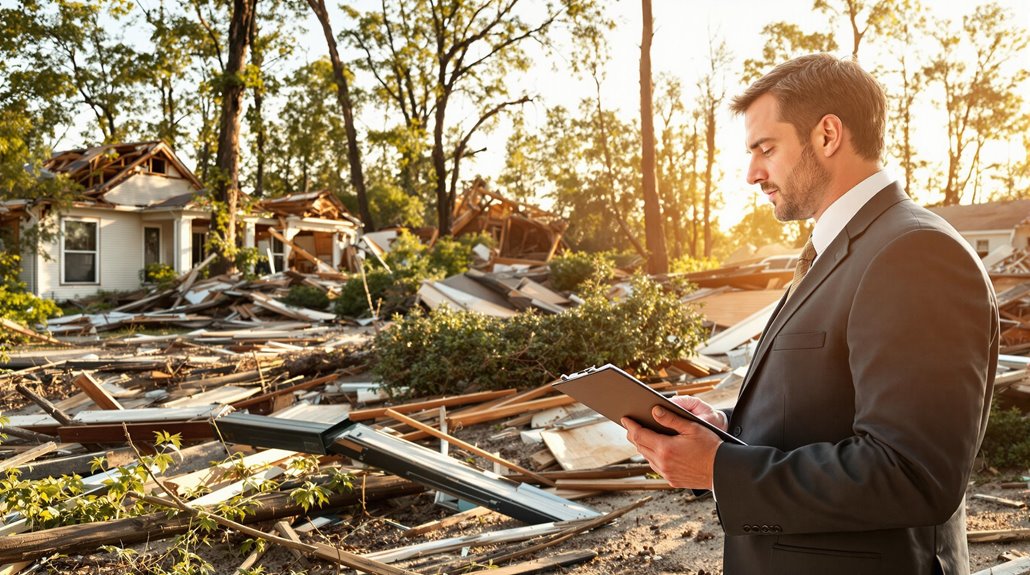Ever wondered what happens when Mother Nature throws her biggest tantrums at your home? That's where catastrophe claims come into play – your insurance policy's heavy-duty response team for major disasters.
Think of catastrophe claims as the emergency room for your home insurance – they kick in when natural disasters like hurricanes, earthquakes, or wildfires wreak havoc on a massive scale. We're talking about events that pack such a punch, they typically cause over $25 million in damages and affect countless homeowners in one fell swoop.
Why should you care? Well, if you're facing a catastrophic event, timing is everything. Insurance companies must acknowledge your claim within two weeks – that's 14 days to get the ball rolling. And here's the real deal: they've got 90 days to either send you a check or explain why they're not paying.
Let's break it down:
- Natural disasters don't RSVP
- Documentation is your best friend
- Time frames matter
- Multiple homeowners are usually affected
Got a catastrophe claim on your hands? Don't worry – while these claims might seem as complex as solving a Rubik's cube blindfolded, understanding the basics puts you ahead of the game. Just remember: proper documentation, timely reporting, and knowing your policy's specifics are your golden tickets to smoother claims processing.
Remember, when disaster strikes, you're not just another policy number – you're a homeowner facing a challenging situation, and your insurance is there to help you bounce back.
Key Takeaways
- Catastrophe claims refer to significant damage from large-scale disasters, including hurricanes, floods, wildfires, tornadoes, and terrorism, exceeding $25 million in losses.
- Insurance policies outline criteria for classifying events as catastrophes, with climate change projected to increase frequency and severity of disasters.
- Catastrophe claims involve higher coverage limits and unique documentation requirements tailored to extensive damage, differing from regular claims.
- Policy provisions, such as Coverage A to D, influence the scope of coverage and compensation for losses, with specific timelines for claims processing.
- Public adjusters can aid in navigating catastrophe claims, enhancing accuracy of damage assessments and ensuring thorough documentation for maximized settlement amounts.
Definition of Catastrophe Claims
Catastrophe claims occupy a distinct category within homeowners insurance. These claims refer to insurance claims filed after significant damage caused by large-scale disasters, such as hurricanes, floods, wildfires, tornadoes, and terrorism, where losses typically exceed $25 million and affect multiple policyholders.
Catastrophic events are distinguished from standard storm damage claims due to their severity and scope. Insurance coverage for catastrophe claims is outlined in homeowners insurance policies, which specify criteria for classifying events as catastrophes. This classification can impact coverage limits and claims processing timelines.
Losses from natural disasters are expected to increase in frequency and severity, with projections indicating that catastrophe losses could double every decade due to climate change and urban development.
As a result, insurance adjusters may encounter challenges accessing disaster zones to process catastrophe claims, underscoring the need for efficient claims processing procedures. Catastrophe claims require specialized handling due to their complexity.
Reporting a Catastrophe Claim

Following a disaster, it is crucial to initiate the claims process promptly by reporting the loss to the insurance company. This step is critical in guaranteeing a smooth and efficient processing of the catastrophe claim. To report a catastrophe claim, policyholders should have their photo ID and insurance policy information readily available for identity verification and to facilitate the reporting process. Working with public insurance adjusters can increase settlement amounts by 30-50% for property damage claims.
| Required Information | Description | Importance |
|---|---|---|
| Photo ID | Verify identity | Guarantees secure reporting |
| Insurance Policy Information | Facilitate reporting | Streamlines claims process |
| Detailed Loss Description | Thorough description of loss or damage | Accurate assessment of damage |
| Updated Contact Information | Guarantee seamless communication | Stay informed on claim status |
| Documentation of Communications | Record of all interactions | Tracks claim progress efficiently |
Following Up on a Catastrophe Claim

How often should policyholders check in on the status of their claim after reporting a loss? Following up on a catastrophe claim is vital to guarantee timely resolution.
Policyholders should maintain a claims notebook with important details, such as the claim number, adjuster's contact information, and date of loss, to facilitate smoother communication with the insurance company.
Regular follow-ups should be conducted, ideally using the organized information to provide context and expedite updates from the insurance provider. Insurers are required to acknowledge claims within specific timelines, making timely follow-ups significant.
Documentation of every interaction with the insurance company, including dates and summaries of conversations, can be beneficial if disputes arise regarding the claim's status or resolution.
Working with a public insurance adjuster can result in significantly higher settlements and professional representation throughout the claims process.
Understanding Catastrophe Claim Timelines

The processing of catastrophe claims is subject to specific timelines, which vary by jurisdiction but typically include deadlines for acknowledgement, status updates, and payment or denial.
In Florida, for example, insurers must acknowledge claims within 14 days, provide status updates within 30 days of receiving proof of loss, and issue payments or denial notices within 90 days from the date of loss.
Understanding these claim processing time frames, filing deadlines, and resolution and payment schedules is essential for homeowners managing the catastrophe claims process.
Claim Processing Time Frames
Uncertainty often surrounds the processing of catastrophe claims, with policyholders seeking clarification on the timelines governing these complex procedures.
Insurance policies typically outline specific processing timelines for catastrophe claims. Upon claim submission, insurers must acknowledge receipt within 14 days, ensuring timely communication with policyholders.
Following proof of loss, insurers have 30 days to provide a status update on the claim. While processing timelines may extend beyond normal periods due to the high volume of claims during major disasters, payments or denial notices must be issued within 90 days of claim submission.
Understanding these timelines helps manage policyholder expectations regarding when repairs and reimbursements may begin, providing essential guidance for homeowners traversing the catastrophe claims process.
Thorough documentation requirements must be met through detailed photos and receipts to avoid delays in catastrophe claim processing.
Catastrophe Claim Filing Deadlines
Promptly addressing the complexities of catastrophe claims, insurers must adhere to specific filing deadlines that facilitate efficient processing.
In Florida, insurers are required to acknowledge a catastrophe claim within 14 days of submission. Following the submission of proof of loss, insurers must provide claim updates within 30 days.
Regulations stipulate that insurers issue payments or denial notices within 90 days from the date the claim is filed. However, during major disasters, claims processing timelines can vary considerably due to the high volume of claims and demand for resources.
Understanding these deadlines is essential for policyholders to manage their expectations and guarantee timely communication with their insurance provider, ultimately streamlining the catastrophe claims process under their homeowners insurance policies.
Working with public adjusters can significantly increase settlement amounts by 30-50% when filing catastrophe claims.
Resolution and Payment Schedules
Following a catastrophe, insurers must navigate the complexities of claims processing to guarantee timely resolution and payment for affected policyholders.
In the context of catastrophe claims under homeowners insurance, insurance companies are bound by specific timelines. They must acknowledge claims within 14 days of submission, ensuring timely communication.
Subsequent updates must be provided within 30 days, keeping policyholders informed of their claims' status. Payments or denial notices must be issued within 90 days.
Although the timeframe may vary based on the disaster's scale, insurers usually prioritize catastrophe claims to expedite resolution.
Homeowners should be aware of these payment schedules and the claims process to manage their expectations and facilitate follow-up actions effectively.
Understanding these timelines is essential for a smooth claims experience.
Working with public adjusters can help ensure maximum claim settlements during catastrophic events.
Essential Coverages for Catastrophe Claims

Homeowners insurance policies comprise multiple coverages that provide financial protection against catastrophic events.
Four essential coverages include Coverage A for the home's structure, Coverage B for other structures, Coverage C for personal belongings, and Coverage D for additional living expenses.
Understanding the specific provisions and applicable limits of these coverages is vital for maximizing catastrophe claim benefits and ensuring adequate financial support during disaster recovery.
Types of Essential Coverage
A thorough homeowners insurance policy is comprised of various coverages designed to mitigate the financial impact of catastrophic events.
These essential coverages provide protection for the home, personal property, and additional living expenses.
Key coverages include:
- Coverage A: Protection for the structure of the home, including walls, roofs, and built-in systems, against catastrophic damage.
- Coverage B: Coverage for other structures on the property, such as garages and sheds, in the event of a catastrophe.
- Coverage C: Protection for personal belongings within the home, including furniture, electronics, and clothing, against losses incurred during catastrophic events.
It is vital for homeowners to review and update coverage limits regularly to guarantee adequate protection against potential catastrophe-related losses.
Understanding Policy Provisions
Policy provisions for catastrophe claims play a significant role in determining the scope of coverage and compensation for losses incurred. Homeowners insurance policies typically include four essential coverages that address damage from catastrophic events.
| Coverage Type | Description | Relevance to Catastrophe Claims |
|---|---|---|
| Coverage A | Protects the structure of the home | Essential for addressing damage from catastrophic events |
| Coverage B | Covers damages to other structures on the property | Impacted by disasters like wildfires or tornadoes |
| Coverage C | Guarantees personal belongings are covered | Significant after catastrophic events with substantial property loss |
| Coverage D | Assists with additional living expenses (ALE) | Helps cover costs like lodging and meals during temporary relocation |
Understanding these policy provisions is important for homeowners to guarantee adequate catastrophe coverage and navigate the claims process effectively. Familiarizing themselves with the specifics can empower homeowners to make informed decisions about their coverage limits and deductibles. Additionally, knowledge of the various emergency measures in homeowners insurance can help mitigate losses during a disaster. By proactively addressing potential risks and understanding their policy, homeowners can ensure they are better prepared to handle unexpected events and the claims that follow.
Differences Between Catastrophe and Regular Claims

While insurance claims are often subject to standard procedures, the nature and extent of damage resulting from catastrophic events necessitate distinct handling procedures.
Catastrophe claims differ greatly from regular claims in several key aspects.
The main differences between catastrophe and regular claims include:
- Coverage Limits: Catastrophe claims involve higher coverage limits to address extensive damage from large-scale disasters, unlike regular claims.
- Documentation Requirements: Unique documentation requirements for catastrophe claims are tailored to the scale of destruction, making them distinct from the documentation needed for regular claims.
- Processing Times and Deductibles: Processing times for catastrophe claims are generally expedited, and specific provisions, such as disaster-related deductibles, may apply based on the nature of the event, differentiating them from standard deductibles in regular claims.
These distinctions reflect the widespread impact and urgency associated with catastrophe claims, which require swift resolution to restore livability.
The Benefits Of Consulting A Public Adjuster

Consulting a public adjuster can provide homeowners with expertise in insurance claims, ensuring a thorough understanding of policy terms and conditions.
A public adjuster's objective damage assessment capabilities also enable accurate evaluations of property damage, reducing the risk of underestimation or overestimation.
Expertise In Insurance Claims
In the aftermath of a catastrophic event, steering through the complexities of homeowners insurance claims can be a challenging task for policyholders. Consulting a public adjuster can provide valuable expertise in maneuvering the claims process.
The benefits of working with a public adjuster include:
- Enhanced accuracy of damage assessments: Public adjusters are experienced professionals who advocate for the policyholder's interests, ensuring that damage is thoroughly documented and accurately assessed.
- Streamlined claims filing: Public adjusters organize documentation and provide guidance on necessary information and evidence required by the insurance company, expediting the claims process.
- Increased claim settlements: Studies indicate that policyholders who use public adjusters receive, on average, 20-30% more for their claims than those who do not, resulting in more thorough compensation for property damage.
Objective Damage Assessment
Accurate damage assessments form the foundation of a successful catastrophe claim. Consulting a public adjuster can provide homeowners with a thorough and objective evaluation of catastrophe losses, ensuring all damages are documented accurately for the claims process.
Public adjusters possess expertise in maneuvering the complexities of insurance policies, enabling them to identify all applicable coverages and filing requirements to maximize the settlement amount. By representing the homeowner's interests, public adjusters advocate for a fair evaluation and compensation for losses incurred during a catastrophic event.
Their involvement can lead to considerably higher settlements compared to handling claims independently, underscoring the value of professional assistance in the damage assessment process.
Streamlined Claim Process
Numerous benefits arise from retaining a public adjuster to facilitate the catastrophe claim process. In the event of a catastrophic loss, a public adjuster can provide expert assistance in documenting and evaluating damages, which is essential during high-demand periods following a disaster.
Benefits of Consulting a Public Adjuster:
- Expert Navigation: Public adjusters can help navigate the complexities of specific disaster-related deductibles and coverage differences in homeowners insurance policies.
- Efficient Resolution: They have extensive experience managing the increased volume of claims, leading to a more efficient resolution process compared to dealing directly with insurance companies.
- Accurate Damage Evaluations: Public adjusters provide objective damage evaluations, ensuring that policyholders receive fair compensation under their homeowners insurance policy.
Higher Claim Payouts & Settlements
The benefits of consulting a public adjuster extend beyond maneuvering the complexities of the claim process to also include maximizing claim payouts and settlements. Public adjusters possess expertise in accurately evaluating damage and understanding policy nuances, leading to higher claim payouts. Their contingency fee basis incentivizes them to maximize settlements, often resulting in 20% to 50% higher payouts compared to homeowners navigating the claims process independently.
| Benefits of Public Adjusters | Impact on Homeowners |
|---|---|
| Expert damage evaluation | Accurate claim valuation |
| Policy nuance understanding | Maximized claim payouts |
| Contingency fee basis | Incentivized to maximize settlements |
| Skilled negotiation | Effective advocacy for homeowners |
| Streamlined claims process | Expedited recovery from catastrophic events |
About The Public Claims Adjusters Network (PCAN)

Policyholders seeking expert guidance with residential and commercial property damage insurance claims can turn to the Public Claims Adjusters Network (PCAN), a national network of pre-vetted, verified, and state-licensed public adjusters.
PCAN serves as a resource for policyholders to connect with expert public adjusters who are pre-vetted, licensed, and experts in their field.
The following benefits are offered by PCAN:
- Expert Guidance: PCAN member adjusters cover over 30 different claim types and are located in 40+ states, providing policyholders with access to specialized knowledge.
- Pre-Vetted Adjusters: All PCAN member adjusters undergo an intensive application and interview process to guarantee they meet the highest standards of ethics, morals, and professionalism.
- Yearly Audits: Mandatory yearly audits of licenses and complaints guarantee that member adjusters maintain the highest standards, providing policyholders with confidence in their chosen adjuster.
Frequently Asked Questions
What Counts as a Catastrophe?
In insurance definitions, a catastrophe is a single-event natural disaster resulting in $25 million or more in damages, impacting multiple policyholders and insurers. Claim processes and coverage limits vary, reflecting risk assessment and often exclusion from standard policy exclusions.
What Is a Catastrophe Claim in Insurance?
A catastrophe claim refers to an insurance claim filed for damages resulting from large-scale natural disasters, governed by specific homeowners insurance terminology, exclusions, and deductibles, requiring prompt filing and specialized processing.
What Is an Example of a Catastrophic Loss?
Catastrophic losses exemplified by natural disasters like hurricanes, wildfires, and earthquakes, result in substantial financial impact, necessitating thorough loss assessment, potentially triggering policy exclusions, and affecting insurance premiums, thereby complicating the recovery process for policyholders.
What Is Catastrophic Coverage for Homeowners Insurance?
Catastrophic coverage for homeowners insurance provides financial protection against catastrophic events, offering higher coverage limits, but often requires separate endorsements for policy exclusions, involves a specialized claim process, and necessitates ongoing risk assessment that affects insurance premiums.








